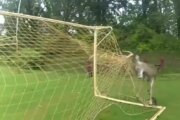Household objects, scrap paper and something to write with can be all it takes for curious kids to express their creativity. Artistic exploration is not limited to a classroom, experts say; parents can engage their children in grades K-8 in process art activities at home that allow them to experiment with everyday materials and use their imagination.
Process Art vs. Product Art
Process art can “refer to any creative making activity that emphasizes exploration and experimentation, rather than focusing on a predetermined outcome or product,” says William B. Crow, director of the Lehigh University Art Galleries in Pennsylvania and professor of practice in the Department of Art, Architecture and Design.
Crow, who previously oversaw educational programming for all ages at the Metropolitan Museum of Art in New York, says process art allows kids the freedom to not be burdened with the criteria of a final product. While parents can assist in the setup, kids are in control of their artistic direction and led by their own discovery rather than set expectations or judgments.
[READ: Affirmations for Kids: How Parents Can Support Their Child’s Learning]
In comparison, product art refers to more structured, results-oriented activities. They are often led by adults and have clear examples and guidelines for the final work.
However, product and process art are not in opposition. From Pooja Bakri’s experience as a licensed creative arts therapist in Montclair, New Jersey, “Kids often have a vision in mind, and the product is always inherent to what they’re doing.” The final product can also be a source of self-discovery and a jumping-off point for reflection and discussion, Bakri says.
What Are the Benefits of Process Art?
From using scissors to explaining creative choices, kids in elementary through middle school can benefit from process art by advancing developmental skills like verbalization, motor skills, spatial reasoning, social-emotional expression and more, experts say. Kids can also apply critical thinking to draw parallels between visual art and another field like math, science, language arts and social studies.
Sean Murphy, an art teacher at Samuel W. Tucker Elementary in Alexandria, Virginia, often relates the arts curriculum to his students’ other classes. When kids learn about quadrilaterals in math, for example, his class focuses on abstract and real life uses of shape. Making these connections, he says, allows students to ask deeper questions and approach their artwork with an interdisciplinary lens.
The artistic process can also open up conversations about artists, art and culture from around the world. Kids benefit from exposure to different cultures and can make discoveries about their own cultural identity through art, Murphy says.
A big advantage of process art, Bakri says, is that kids can “express themselves in a way that comes more naturally” — it allows them to externalize their thinking through visual expression. Crow agrees, noting that “when engaging in process art, in many ways we’re extending the scope of our mind. We’re really making the invisible visible. We’re trying to articulate things that didn’t exist in the world before.”
How Can Parents of K-8 Students Facilitate Process Art?
For parents and caregivers of elementary and middle school learners, here are four tips to step back and allow kids the freedom to learn and play through process art:
— Use common materials found at home.
— Provide a broad theme.
— Consider different approaches based on age.
— Ask open-ended questions.
Use Common Materials Found at Home
“Kids have a wealth of ideas and imagination,” Bakri says, and she delights in seeing them put together something she would never have thought to create. Interesting and unique materials invite exploration, which means art materials do not have to start and end with paint and markers.
Experts suggest providing kids with a lot of different options, which do not have to be expensive or high quality. “By using nontraditional, low-cost materials,” Crow says, “you’re communicating the message that art and art making isn’t dependent on having access to expensive, highly specialized materials, but can be made from the everyday.”
Here are just a few ideas to get started:
— Yarn
— Leaves
— Rocks
— Colorful masking tape
— Shaving cream
— Plastic utensils
— Paper plates
— Cookie sheets
— Cotton balls
For inspiration, Crow suggests looking at works from various artists and researching the materials they used. Then, rather than trying to emulate or reproduce the work, kids can experiment with those materials themselves and learn about the process.
Many local art museums have in-person and online resources for parents to help get kids started thinking about materials from different artworks. If a parent is unsure where to find their local art museum, Crow suggests consulting the American Alliance of Museums or looking for local college and university galleries through the Association of Academic Museums and Galleries.
[READ: Virtual Field Trips for Kids: Worldwide Wonders.]
Provide a Broad Theme
While parental guidance is helpful to begin process art activities, experts say it is important not to direct a child’s art with specific prompts or directions. Instead, one way to kick-start the creative flow is to simply ask, “What can we do with these materials?” and to let a theme form naturally.
In her therapy sessions, Bakri uses a simple word or phrase like “dream,” and from there kids can think about the concept as it applies to them. They can consider what feelings the word or phrase evokes and take their art in any direction without the weight of a parent’s expectations.
Keeping the theme broad can lead to healthy emotional expression, Bakri says. “We can’t assume that we know what’s going on with a child or their feelings. We may see something on the outside that looks like anger, but inside it’s actually about frustration or sadness.”
Process art can allow kids to freely show parents their inner thoughts and emotions, without a child having to respond verbally or even make eye contact if they are not comfortable.
Consider Different Approaches Based on Age
Experts suggest parents facilitating process art take into account the age of their children so that their approach is developmentally appropriate.
Kindergarten to fourth grade. Elementary school kids are often very direct and sincere in how they communicate. “They are also very eager to tell stories about what they notice,” Crow says. He recommends parents encourage their young children to use those impulses in their art.
Similarly, Murphy wants his elementary school students to ask a lot of questions about art. When looking at other works of art for inspiration, he guides the discussion from concrete concepts like, “Let’s identify what we see,” to more abstract ideas by having kids make educated guesses about the process and intention behind a work. For example, he will have them finish the statement, “Because I see this, this is what I wonder … ”
Bakri often integrates a lot more play into her sessions with younger kids, who typically have higher energy. She may read a story, do some art and play with different tactile materials all in one session to keep up with children’s need for a variety of stimulation.
Fifth grade to eighth grade. As kids reach early adolescence, social pressures and peer awareness can sometimes inhibit their creative practices, Crow says.
With his fifth graders, Murphy likes to encourage experimentation and failure to promote confidence. By the end of fifth grade, his students have used the same sketchbooks throughout elementary school, which allows them to reflect on their growth and try out iterations of works. Mistakes are welcomed.
In practice, Bakri says, “Adolescents are able to focus a little bit more, and they often need much less directive.” They can typically work on a project that lasts several weeks and look into the various layers involved.
[READ: Summer Reading: Book Ideas for Parents of K-8 Students.]
Ask Open-Ended Questions
Process art is centered around the learner, and as such, “should be driven by the intrinsic motivations of the learner,” Crow says.
Parents often ask results-oriented questions with a “yes” or “no” answer. It may take some practice to ask open-ended questions that, Crow says, “really encourage a young person to tell a story, or expand on an idea, or explore all the different possibilities.”
Bakri suggests the following: “Rather than interpreting or saying, ‘Oh, that looks like this,’ ask a really open-ended question, like, ‘What inspired you?'” The question then becomes more of a conversation than a directive, and it keeps the process playful and the child present in the moment.
She recommends making specific observations as well, such as, “‘I see that you were working really hard on this part.'”
Murphy agrees, noting that “giving them encouragement that’s not, ‘What a pretty picture,’ but rather emphasizing how hard they worked” places importance on their problem-solving abilities.
Lastly, parents can ask their kids to ask them questions, too. “Kids are getting asked questions all of the time and being told what to do,” Bakri says. Process art allows them to turn the tables and have control over their artwork — and their emotions.
Searching for a school? Explore our K-12 directory.
More from U.S. News
Choosing a Summer Camp for Your K-8 Child
How to Celebrate Your Child’s 8th Grade Graduation
Process Art for Kids: What Parents Should Know originally appeared on usnews.com







